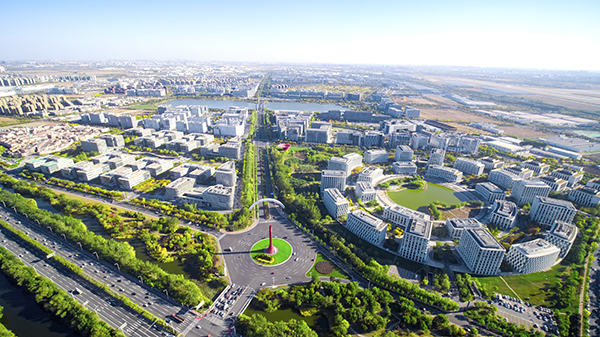Tianjin Port Free Trade Zone
Updated : 2023-06-14
Print Print
Established on May 12, 1991, the Tianjin Port Free Trade Zone became the second free trade zone in China and the first in northern China. On December 22, 2017, the Lingang Economic Zone was integrated into the Tianjin Port Free Trade Zone.This integration created a spatial layout known as the "Three Zones and Two Ports," emcompassing the seaport, airport, and Lingang areas. This set up takes full advantage of the abundant maritime and aerial resources of Tianjin Port and Tianjin Binhai International Airport.
The Tianjin Port Free Trade Zone has a planned area of 223.2 square kilometers, with an actual management area of 173.2 square kilometers. This includes a seaport area of 6.2 square kilometers, an airport area of 56 square kilometers, and a Lingang area of 111 square kilometers. The zone manages three special customs supervision areas with a total area of 7.27 square kilometers, including the Tianjin Port Bonded Zone and the Binhai New Area Bonded Zone.
The planned port coastline stretches 44.8 kilometers, with an annual throughput capacity of 116 million tons. The population of the free trade zone, including 40,000 permanent residents and 80,000 industrial workers.
The Tianjin Port Free Trade Zone is centered around the goal of constructing a "modernized bonded zone" and follows an approach that emphasizes the equal importance of the maritime and aerial sectors, the integration of innovation with practicality, and the fusion of industry with urbanization. The zone focuses on the cultivating new growth drivers and is committed to expanding reform and opening up, advancing economic development, and optimizing the business environment. It consistently implements practical measures and remains at the forefront of various economic and social initiatives.
In 2022, the Zone continued to consolidate its "hundred-billion-trillion" development scale. The local general budget revenue reached 10.19 billion yuan, marking a 2% increase compared to the previous year. The GDP reached 112.824 billion yuan, a 3.9% increase. The sales volume of commodities above the quota surpassed 1 trillion yuan, reaching 1,060.67 billion yuan, roughly maintaining the previous year’s level.
The value-added of large-scale industries reached 180.31 billion yuan, a 5.8% increase. Domestic investment reached 44.21 billion yuan, a 10.4% increase; while the actual utilization of foreign investment reached $870 million, reflecting a 20.5% increase.
The free trade zone implements the strategies of "making the city thrive through manufacturing" and becoming a "manufacturing powerhouse," advancing the modernization and high-end development of the manufacturing industry. It aims to create four signature industry chains: the marine economy, civil aviation, biomanufacturing, and hydrogen energy, as well as two advantageous industry chains in intelligent technology and high-end equipment. Additionally, it focuses on three pillar industry chains in fast-moving consumer goods, metal products, and new materials, thus forming a "4+2+3" modern industrial system.
The industrial structure of the Zone continues to optimize, with the proportion of secondary and tertiary industries now balanced at 35:65. High-end industries are showing strong growth momentum, with the output value of strategic emerging industries reaching 53.79 billion yuan in 2022, a 13.7% increase compared to the previous year. This accounts for 34.8% of the total industrial output value in the entire area. The value-added of high-tech manufacturing industries increased by 26.4%.
The civil aviation industry accounts for over 90% of the total output value in the city. Airbus delivered 52 aircraft from the A320 series and 10 aircraft from the A350 series. The A321 project was put into production as scheduled, and the production capacity of the Airbus A320 aircraft body system assembly project has been expanded. Comprehensive preparations for the operation of the second production line for the A320 have been fully initiated.
The service industry continues to grow, with revenue from profit-oriented services reaching 77.4 billion yuan, a 20% increase compared to the previous year. The income from modern emerging services exceeded 120 billion yuan.